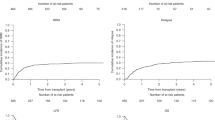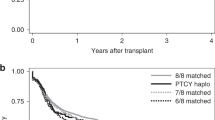Abstract
HLA-C matching is an important determinant of outcome after myeloablative unrelated donor (URD) hematopoietic stem cell transplantation. However, its importance in non-myeloablative stem cell transplantation (NST) is not known. We report a retrospective analysis of 111 patients who underwent URD NST, of whom 78 were 10/10 matched at HLA-A, B, C, DRB1, DQB1 and 33 were mismatched at one or more HLA-C antigen/allele (24 HLA-C only; nine HLA-C+other locus mismatch). Patients were conditioned with busulfan (0.8 mg/kg/day i.v. × 4 days) and fludarabine (30 mg/m2/day i.v. × 4 days). Graft-versus-host disease prophylaxis included cyclosporine/prednisone- or tacrolimus/mini-methotrexate-based regimens. HLA-C disparity did not impair engraftment. Median marrow donor chimerisms were ⩾90% donor at day+30 and +100 in both groups. Overall survival at 2 years was 30% in HLA-C-mismatched and 51% in 10/10-matched patients (P=0.008). In Cox regression, HLA-C mismatch was an independent predictor of death (hazard ratio 1.85, P=0.04). Treatment-related mortality was higher in the HLA-C-mismatched group: 48 versus 16% (P=0.0001). Cumulative relapse incidence was 35% in the HLA-C-mismatched and 55% in the 10/10-matched cohort, P=0.09. HLA-C mismatch is associated with inferior survival after URD NST.
This is a preview of subscription content, access via your institution
Access options
Subscribe to this journal
Receive 12 print issues and online access
$259.00 per year
only $21.58 per issue
Buy this article
- Purchase on Springer Link
- Instant access to full article PDF
Prices may be subject to local taxes which are calculated during checkout



Similar content being viewed by others
References
Maris MB, Niederwieser D, Sandmaier BM, Storer B, Stuart M, Maloney D et al. HLA-matched unrelated donor hematopoietic cell transplantation after nonmyeloablative conditioning for patients with hematologic malignancies. Blood 2003; 102: 2021–2030.
Alyea EP, Kim HT, Ho VT, Cutler C, Gribben J, DeAngelo DJ et al. Comparative outcome of nonmyeloablative and myeloablative allogeneic hematopoietic cell transplantation for patients older than 50 years of age. Blood 2005; 105: 1810–1814.
Giralt S, Thall PF, Khouri I, Wang X, Braunschweig I, Ippolitti C et al. Melphalan and purine analog-containing preparative regimens: reduced-intensity conditioning for patients with hematologic malignancies undergoing allogeneic progenitor cell transplantation. Blood 2001; 97: 631–637.
Niederwieser D, Maris M, Shizuru JA, Petersdorf E, Hegenbart U, Sandmaier BM et al. Low-dose total body irradiation (TBI) and fludarabine followed by hematopoietic cell transplantation (HCT) from HLA-matched or mismatched unrelated donors and postgrafting immunosuppression with cyclosporine and mycophenolate mofetil (MMF) can induce durable complete chimerism and sustained remissions in patients with hematological diseases. Blood 2003; 101: 1620–1629.
Nagler A, Aker M, Or R, Naparstek E, Varadi G, Brautbar C et al. Low-intensity conditioning is sufficient to ensure engraftment in matched unrelated bone marrow transplantation. Exp Hematol 2001; 29: 362–370.
Petersdorf EW, Hansen JA, Martin PJ, Woolfrey A, Malkki M, Gooley T et al. Major-histocompatibility-complex class I alleles and antigens in hematopoietic-cell transplantation. N Engl J Med 2001; 345: 1794–1800.
Flomenberg N, Baxter-Lowe L, Confer D, Fernandez-Vina M, Filipovich A, Horowitz M et al. Impact of HLA-class I and class II high resolution matching on outcomes of unrelated donor BMT. Blood 2001; 98: 813a.
Petersdorf EW, Gooley TA, Anasetti C, Martin PJ, Smith AG, Mickelson EM et al. Optimizing outcome after unrelated marrow transplantation by comprehensive matching of HLA class I and II alleles in the donor and recipient. Blood 1998; 92: 3515–3520.
Sasazuki T, Juji T, Morishima Y, Kinukawa N, Kashiwabara H, Inoko H et al. Effect of matching of class I HLA alleles on clinical outcome after transplantation of hematopoietic stem cells from an unrelated donor. Japan Marrow Donor Program. N Engl J Med 1998; 339: 1177–1185.
Petersdorf EW, Smith AG, Mickelson EM, Longton GM, Anasetti C, Choo SY et al. The role of HLA-DPB1 disparity in the development of acute graft-versus-host disease following unrelated donor marrow transplantation. Blood 1993; 81: 1923–1932.
Flomenberg N, Baxter-Lowe LA, Confer D, Fernandez-Vina M, Filipovich A, Horowitz M et al. Impact of HLA class I and class II high-resolution matching on outcomes of unrelated donor bone marrow transplantation: HLA-C mismatching is associated with a strong adverse effect on transplantation outcome. Blood 2004; 104: 1923–1930.
Petersdorf EW, Anasetti C, Martin PJ, Gooley T, Radich J, Malkki M et al. Limits of HLA mismatching in unrelated hematopoietic cell transplantation. Blood 2004; 104: 2976–2980.
Gray R . A class of K-sample tests for comparing the cumulative incidence of a competing risk. AnnStat 1988; 16: 1141–1154.
Bishara A, Amar A, Brautbar C, Condiotti R, Lazarovitz V, Nagler A . The putative role of HLA-C recognition in graft versus host disease (GVHD) and graft rejection after unrelated bone marrow transplantation (BMT). Exp Hematol 1995; 23: 1667–1675.
Nagler A, Brautbar C, Slavin S, Bishara A . Bone marrow transplantation using unrelated and family related donors: the impact of HLA-C disparity. Bone Marrow Transplant 1996; 18: 891–897.
Petersdorf EW, Longton GM, Anasetti C, Mickelson EM, McKinney SK, Smith AG et al. Association of HLA-C disparity with graft failure after marrow transplantation from unrelated donors. Blood 1997; 89: 1818–1823.
Morishima Y, Sasazuki T, Inoko H, Juji T, Akaza T, Yamamoto K et al. The clinical significance of human leukocyte antigen (HLA) allele compatibility in patients receiving a marrow transplant from serologically HLA-A, HLA-B, and HLA-DR matched unrelated donors. Blood 2002; 99: 4200–4206.
Acknowledgements
This study was supported, in part, by the Ted and Eileen Pasquarello Leukemia Research Fund, and NIH Grant 5 PO1 HL070149-03.
Author information
Authors and Affiliations
Corresponding author
Additional information
Results of this study were presented, in part, at the meeting of American Society of Blood and Marrow Transplantation, Keystone, CO, February 2005, and the meeting of the American Society of Hematology, Atlanta, GA, December 2005.
Rights and permissions
About this article
Cite this article
Ho, V., Kim, H., Liney, D. et al. HLA-C mismatch is associated with inferior survival after unrelated donor non-myeloablative hematopoietic stem cell transplantation. Bone Marrow Transplant 37, 845–850 (2006). https://doi.org/10.1038/sj.bmt.1705315
Received:
Revised:
Accepted:
Published:
Issue Date:
DOI: https://doi.org/10.1038/sj.bmt.1705315
Keywords
This article is cited by
-
Long-term follow-up of a single institution pilot study of sirolimus, tacrolimus, and short course methotrexate for graft versus host disease prophylaxis in mismatched unrelated donor allogeneic stem cell transplantation
Annals of Hematology (2019)
-
Reduced-intensity conditioned allogeneic SCT in adults with AML
Bone Marrow Transplantation (2015)
-
Predictive impact of allele-matching and EBMT risk score for outcome after T-cell depleted unrelated donor transplantation in poor-risk acute leukemia and myelodysplasia
Leukemia (2011)
-
Reduced-intensity conditioning by fludarabine/busulfan without additional irradiation or T-cell depletion leads to low non-relapse mortality in unrelated bone marrow transplantation
International Journal of Hematology (2011)



